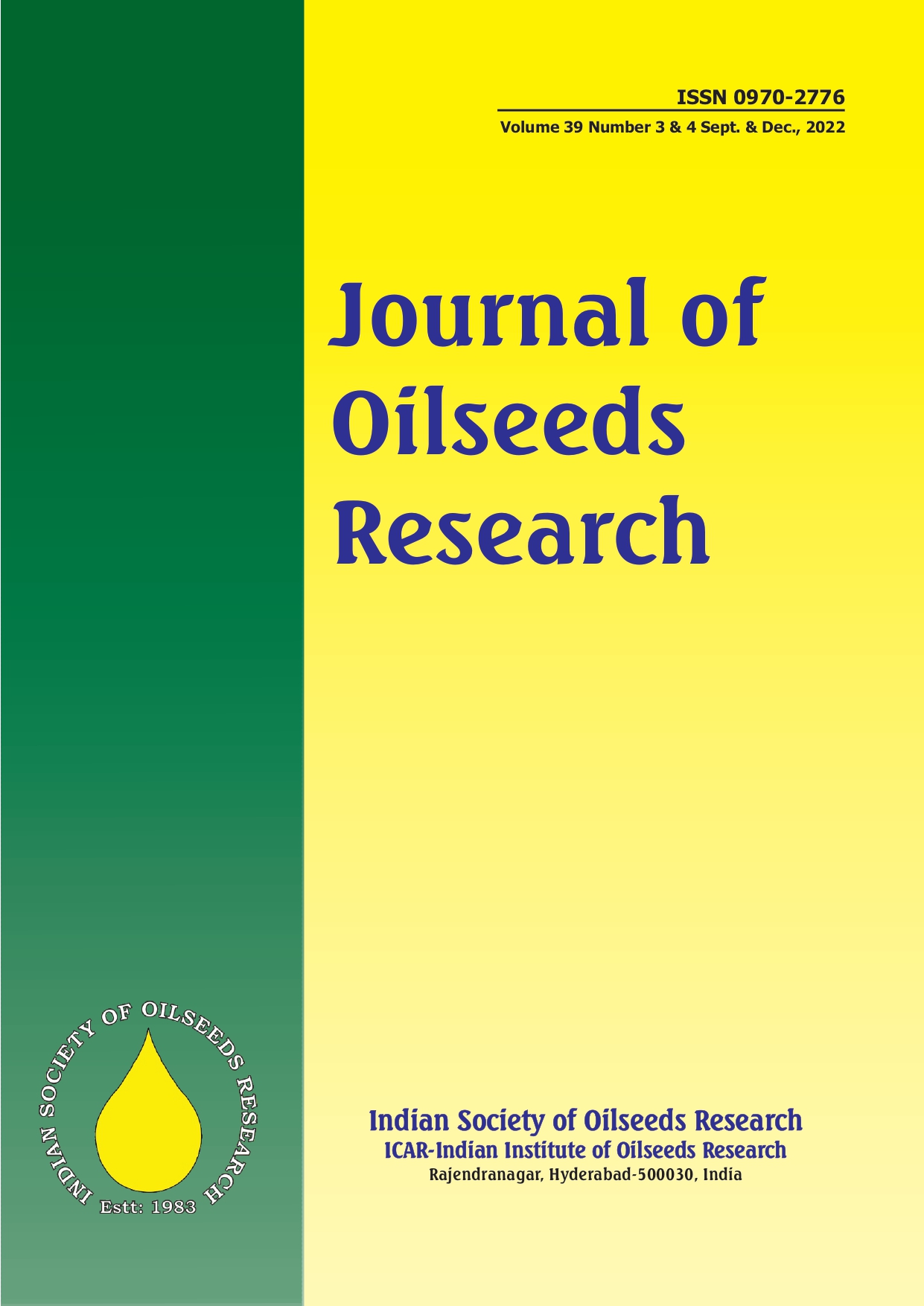Variability in Alternaria lini causing leaf blight disease of linseed (Linum usitatissimum L.)
VARIABILITY IN ALTERNARIA LINI CAUSING LEAF BLIGHT DISEASE OF LINSEED
336 / 2
Keywords:
Alternaria lini, Cultural, Isolates, Linseed, Morphological, Pathogenic, VariabilityAbstract
Alternaria blight is an important disease of linseed that hampers its productivity and oil content. The pathogen is geneticallydiverse showing variability in respect of cultural, morphological and pathogenic characters. Variability in seventeen isolates of Alternaria lini was carried out. Studies on cultural variability showed considerable variation among the isolates. The colony diameter varied from 46.67- 71.67 mm after 96 hrs. of incubation and most of the isolates recorded medium growth rate (50-64mm). The isolates Alt-6,Alt-7 Alt-12 showed fast growth habit (>65mm). The colony colour varied from grayish white, grey, dark olive green to grayish black. Sporulation in most of the isolates were late and concentric ring was present only in four isolates (Alt 3, Alt 8, Alt 13, Alt 14) while zonation was completely absent in other isolates. Morphologically different isolates of A. lini revealed variation with respect to mycelium width, size, shape, colour and septation of conidia. Mycelial width of most of the isolates having moderate to long width. Conidial length ranged from 24.87-33.68 mm similarly breadth of conidia ranged from7.54-10.67 mm. Transverse septation were more than longitudinal septation. Variation in beak size ranged from 3.5-6.4 mm while colour of conidia varied from brown to dark brown colour and most of the isolates exhibited obclavate, oval to obclavate shaped conidia while one isolate appeared as oval shaped. Studies on pathogenic variations revealed that the variation observed in accordance with the latent period, lesion size, lesion shape and plant disease index. The latent period of A. lini isolates varied from4.75 to 6.25 days with shortest (4.75 days) latent period recorded by isolates Alt-3 and Alt-11 and longest latent period of 6.25 days was observed in isolates Alt-6, Alt-14, Alt-16. The size of lesion varied from 2.25 to 4.75 mm and maximum lesions size (4.75 mm) was observed in isolate Alt-4 whereas minimum lesion size (2.25 mm) was observed in isolate Alt-5. The lesion produced after inoculation were elongated, oval and irregular in shape. The average number of lesions ranged from 2.75 to 4.00 with maximum number (4.00) of lesion recorded in isolate Alt-13. Plant disease index revealed that Meera and Nagarkot were more severe/virulent compare to Divya and Priyam in all the isolates.
Downloads
References
Asma H H, Ajithkumar K, Savitha A S, Yenjerappa S T, Govindappa M R and Krishnamurthy D 2021. Studies on host range of Alternaria spp. causing blight disease in linseed. Journal of Oilseeds Research, 38(3): 300-302.
Charpe A M, Bhoye B B and Gade R M 2014. Fungistasis of Trichoderma culture filtrates against Alternaria lini that causes bud blight of linseed. Journal of Plant Disease Sciences, 9: 86-90.
Dey P K 1933. An Alternaria blight of linseed of plant. Indian Journal of Agricultural Sciences, 111: 881-896.
Dwivedi S K, Satyaraj Guru R K and Panda S 2021. Foliar application of plant growth regulators on growth, yield and economics of linseed (Linum usitatissimum L.). Journal of Oilseeds Research, 38(2): 195-198.
Ginoya C M and Gohel N M 2015. Cultural and morphological variability among the isolates of Alternaria alternata (fr.) Keissler, incitant of fruit rot of chilli. International Journal of Plant Protection, 8: 118-125.
Groves J W and Skolko A J 1944. Note on seed borne fungi, II. Alternaria. Canadian J. Res., 22: 217- 234.
Jankar K D, Bagde E D and Tatte R R 2018. Morphological and pathogenic variation ofAlternaria alternata causing fruit rot of chilli. International Journal of Chemical Studies, 6: 843-848.
Keitt G W 1905. Technique of isolating fungi. Phytopathology, 5: 266-269.
Kumar N and Biswas S K 2019. Molecular and pathogenic variability of multilocus isolates of Alternaria lini Dey cause Alternaria blight in linseed (Linum usitatissimum L.). Journal of Pharmacognosy and Phytochemistry, 8: 1360-1364.
Meena R K, Sharma S S and Singh S 2014. Studies on variability in Alternaria alternata (Kessler) causing leaf blight of Isabgol (Plantago ovata). SAARC Journal of Agriculture, 12: 63-70.
Moshin S M, Islam M R, Ahmmed A N F, Nisha H A C and Hasanuzzaman M 2016. Cultural, morphological and pathogenic characterization of Alternaria porri causing purple blotch of onion. Notulae Botanicae Horti Agrobotanici Cluj-Napoca. 44: 222-227.
Sharma R B, Arjariya A and Singh R 2015. Blight disease of linseed with its effects on oil quality and ethnomedicinal control. Periodic Research, 4: 22-26.
Shingne A W, Bagade A R, Usendi P N and Gir G K 2020. Morphological, cultural and pathological variation of Alternaria alternata causing leaf spot of niger. International Journal of Current Microbiology and Applied Sciences, 9: 3300-3306.
Verma A K and Singh R B 2017. Cultural and Morphological variability of Alternaria lini isolates causing blight of linseed. International Journal of Research in Agricultural Sciences, 7: 361-372.
